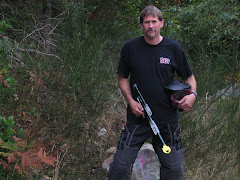I wrote the following on another site (View From the Deadbox) as a response to someone whose opinion I respect who suggested the industry hasn't/hadn't done enough to promote tournament paintball, but instead pushed "warlike" recreational paintball too much. Since I haven't posted much here because I'm getting lazy (or too busy, you choose), I thought I would throw it up so y'all don't think I'm doing nothing at all. Here goes:
I’m not sure what else you wanted the industry to do. You certainly
didn’t expect Tippmann and the like to abandon their very profitable
business of supplying their customers what they demanded did you? If
you did that was just wishful thinking. The industry has always made
efforts to supply a broader market. Abandoning non-competitive type
play for competitive type play will never happen. Product lines
expanded and many, many fields opened with tournament type only
fields and many others added tournament type fields to their mix. When I
went into the business, the buzz I heard everywhere was that the future
in paintball lay in speedball. This was 2001. I fully intended to go
into the speedball market (who in their right mind would want to miss
out on a shifting trend?), as were most of the other fields in the area.
My competitors were actively recruiting players from the “rec”
business to join the fun on the speedball fields (the owners themselves
were heavily involved in tournament play, so it was their passion). But
in the end, after all their efforts, they could never attract enough
participants to make it a viable business, it was always a sideline that
they had to inject funds into (rather than take funds out of).
Now,
had all us field owners abandoned their “rec” businesses completely and
speedball were all that was offered, then sure, competitive paintball
would have grown more, although most would just be playing “rec”
paintball on speedball fields, but we would have also alienated a huge
portion of the market that does not want to play on small fields, with
extreme rates of fire, and large numbers of paintballs. What
(intelligent) industry would abandon a large part of their customer base
to try to convert them into customers of their other product line and in the process alienating (losing) many of them? We
don’t see cheap fast food restaurants closing, in hopes that everyone
will start eating at high end restaurants.
If the “sport” of paintball wants to grow, then it needs to concentrate
on its product. Competitive paintball, although using similar equipment
as recreational paintball, is a totally different business, with a
totally different product, and totally different demands of their
customer base. Tournament type paintball needs to stop thinking about
converting rec players, but needs to concentrate on creating
something that enough people want to take part in, and more importantly,
can afford to take part in. If you want to create “Demand”, which is
what you are trying to do, then you need to “Supply” what people might want at
a price they feel is worth spending.
I agree that a lot of
people want to play sports and I believe there is a much bigger demand
for competitive style paintball than is currently being supplied to. I
know many, many “rec” players that tried to get into the competitive
paintball scene, only to be jaded, mostly by the cost (although that is
not the only issue). The product that is being supplied at the cost
demanded of the customer, can’t keep those customers, even though they
dearly want to play the “sport”. I’m sure we all know many people like
that.
The problem I see with the evolution of tournament
paintball, is that field owners tried to build a product based on
“volume”. However, the “volume” was paintballs, and not customers.
They figured if they could get everyone shooting more paintballs, they
would sell more paintballs and make the whole thing profitable. That
whole concept has three very basic flaws though. First, as you sell
more, the price goes down, so the field owners end up making the same or
maybe even less per customer. Second, supplying a product based on
extreme rates of fire, eliminates a very large portion of the
population. Third, those that are willing to take part, because of the
high volumes of paint necessary, even though relatively cheap, need to
spend a lot of money compete. Now you’ve created a product that only a
small percentage are willing to take part in due to the extremity level,
is very costly for those that do want to take part, and is not
profitable for those supplying the product. Three strikes....you’re
out!
Stock Class
7 years ago


No comments:
Post a Comment